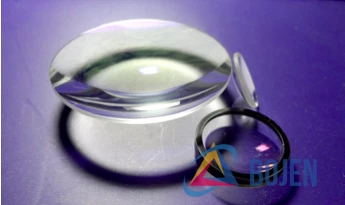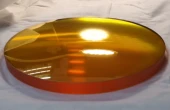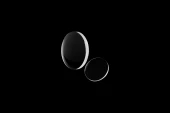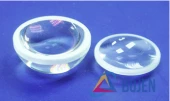Description
The Positive Meniscus (Convex-Concave) Lens is an essential optical component designed to optimize performance by minimizing spherical aberration. These lenses are characterized by their unique shape, featuring a convex surface on one side and a concave surface on the other. This design is particularly beneficial when the lens is used in conjunction with another lens, as it effectively shortens the focal length and increases the numerical aperture (NA) of the system. This enhancement is achieved without introducing significant spherical aberration, making these lenses a preferred choice for precise optical applications.
For applications involving the focusing of a collimated beam, the positive meniscus lens is ideally positioned with its convex side facing the light source. This orientation helps to further reduce spherical aberration, ensuring optimal performance. The focal length of each lens is determined by the equation: f = (R1*R2)/((n-1)*(R2-R1)), where n represents the index of refraction, and R1 and R2 are the radii of curvature for each surface of the lens. This formula allows for precise calculations and adjustments to meet specific optical requirements.
To enhance durability and performance, these lenses can be coated with Magnesium Fluoride (MgF2) to protect the surface or with anti-reflective (AR) coatings to increase light transmission. These coatings are crucial in maintaining the integrity and efficiency of the lens in various environmental conditions and applications. The versatility and precision of the Positive Meniscus (Convex-Concave) Lens make it an invaluable component in advanced optical systems.
Positive Meniscus Convex-Concave Lens
Specifications
| Material: | BK7, FS, UVFS, CaF2, ZnSe, Ge, H-K9L |
|---|---|
| Diameter: | 3 mm |
| Available Focal Lengths: | 100mm to 1000mm |
| Available Diameters: | 3mm to 200mm |
| Surface Roughness (Scratch & Dig): | 80/50 to 20/10 |
Features
- Focal Lengths Available: Ranges from 100.0 mm to 1000.0 mm
- Focal Length Tolerance: ±1%
- Diameter: 3.0 mm to 200.0 mm
- Scratch & Dig: 80/50 to 20/10
- Spherical Surface Power: 5 Fringes to 1 Fringe
- Spherical Surface Irregularity: λ/2 to λ/8
- Center Error: 5 arc min to 30 arc sec
- Design Purpose: Minimizes spherical aberration, shortens focal length, and increases numerical aperture (NA) when used in combination with another lens.
- Beam Focusing: When focusing a collimated beam, the convex side of the lens should face the source to minimize spherical aberration.
- Focal Length Calculation: f = (R1 * R2) / ((n-1) * (R2-R1)), where n is the index of refraction and R1, R2 are the radii of curvature for each surface of the lens.
- Coating Options: Can be coated with MgF2 for surface protection or AR coated to increase transmission.
Applications
- Imaging Systems: Enhance clarity and focus with minimized aberration in optical assemblies
- Laser Focusing: Effective beam focusing with optimal performance when convex side faces the source
- Beam Shaping: Adjust focal length and NA in beam expansion and shaping systems
- Optical Instrumentation: Integrated into instruments requiring precise focus control
- Research & Development: Ideal for optical experiments demanding high accuracy and reliability
Frequently Asked Questions
What is a positive meniscus (convex-concave) lens?
What is the function of a positive meniscus lens?
How should a positive meniscus lens be oriented when used to focus a collimated beam?
What is the range of focal lengths available for positive meniscus lenses?
Can positive meniscus lenses be coated to protect the surface or increase transmission?
Similar Products
Your inquiry has been received.
Create an account by adding a password
Why create an account?
- Auto-complete inquiry forms
- View and manage all your past messages
- Save products to your favorites
- Close your account anytime — no hassle




